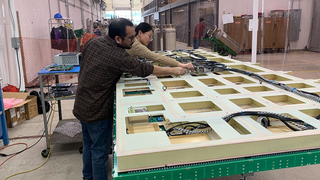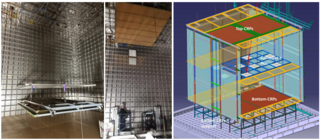ProtoDUNE detectors at CERN are designed to test the technologies and techniques that will be used in the full-scale DUNE experiment. The first ProtoDUNE detector started operations in September 2018, and a second prototype detector is now being prepared for testing at CERN.
A collaborative effort at Wright Lab
Wright Lab is one of the CRP assembly sites in the international DUNE collaboration. The recent CRP assembly effort at Wright Lab has been a collaboration between Yale University, Brookhaven National Laboratory (BNL)-–which has a strong research partnership with Yale, including a long-standing collaboration in the physical sciences-–the University of Chicago, and the University of Iowa; led by Principal Investigator Karsten Heeger, Eugene Higgins Professor of Physics at Yale, chair of the Yale Physics Department, and Director of Wright Lab.
Heeger said, “Wright Lab’s unique facilities and infrastructure–including high bay assembly space, expert technical professionals, and dedicated support personnel–were critical for the recent successful work for DUNE”.
In addition to Heeger, Wright Lab’s Govinda Adhikari, postdoctoral associate; James Wilhelmi, research support specialist; Lee Hagaman, graduate student; Jeff Ashenfelter, operations director; and research technicians Tom Hurteau, Frank Lopez, and Craig Miller participated in this effort.
Adhikari said, “I am pleased with the hands-on experience and lessons learned from setting up a clean room, conducting the assembly, and testing of CRPs in various temperatures. Wright Lab is equipped with the necessary resources, and provided an exceptional environment for the successful production of one of the vital components of the far detector for the DUNE experiment.”
Adhikari continued, “Our team has developed the necessary competencies and confidence to consistently produce charge readout planes, which is critical in meeting the goals of the collaboration.”
Collaborators from other institutions include Augie Hoffman, Hanjie Liu, and Matt Worcester from BNL; Chris Macias from the University of Iowa; and Avinay Bhat, a recent Wright Lab postdoctoral alumnus who is now at the University of Chicago.
Assembly



